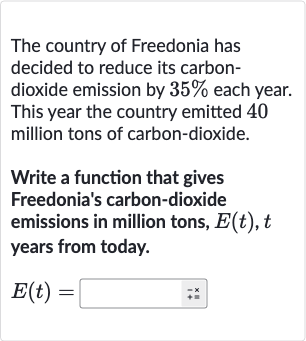AI tutor
Full solution
Q. The country of Freedonia has decided to reduce its carbondioxide emission by each year. This year the country emitted million tons of carbon-dioxide.Write a function that gives Freedonia's carbon-dioxide emissions in million tons, years from today.
- Understand Exponential Decay: To create a function that models the carbon-dioxide emissions in Freedonia years from today, we need to understand that a reduction of each year means that each year, Freedonia will emit only () of the carbon-dioxide it emitted the previous year. This is an example of exponential decay, and the general formula for exponential decay is:where: is the amount after years, is the initial amount (the amount today), is the decay rate (as a decimal), and is the time in years.Given that the initial amount of carbon-dioxide is million tons and the decay rate is , or as a decimal, we can substitute these values into the formula.
- Convert Percentage to Decimal: First, we convert the percentage reduction to a decimal by dividing by . So, becomes .Next, we subtract this decimal from to find the percentage that remains each year. This gives us .Now we can write the function for using the initial amount of carbon-dioxide, which is million tons, and the decay factor, which is .
- Write Emission Function: The function now represents the carbon-dioxide emissions in million tons, years from today. This function can be used to calculate the emissions for any given year by substituting the value of into the function.To check for any mathematical errors, let's consider the case when , which should give us the initial value of million tons.Since any number to the power of is , and times is , the function checks out for .

